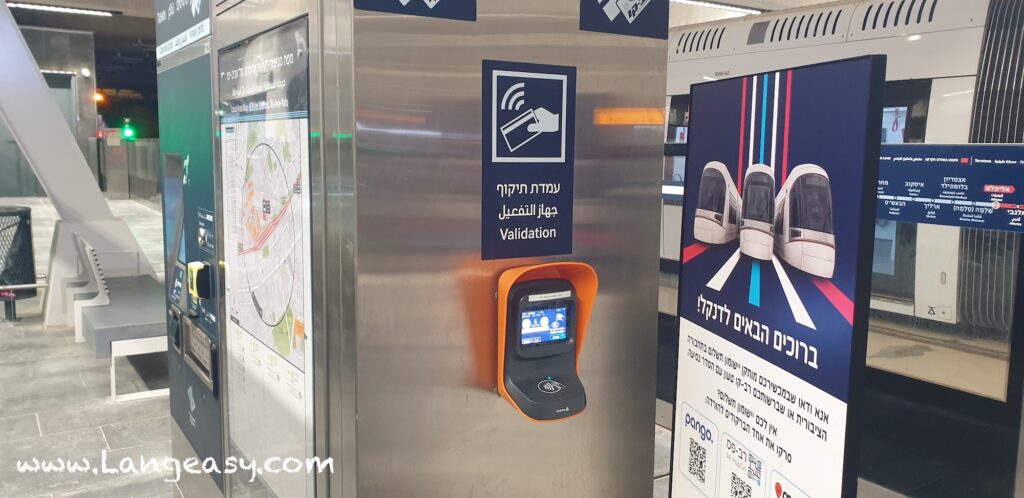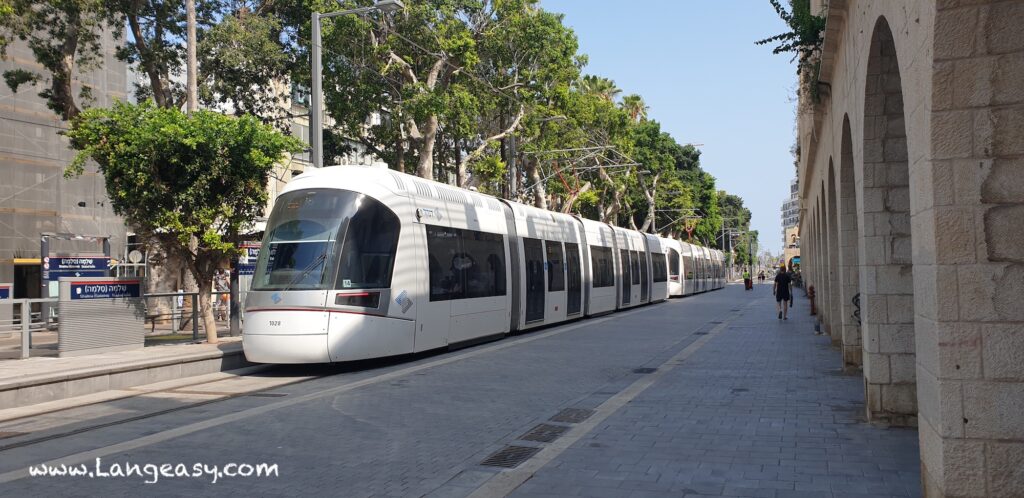How to Pay for the Transports in Israel ?
There are 3 ways :
- With a Paper Ticket
- With an electronic card called Rav-Kav card.
- Via a Smartphone Application.
See later, which is the best way
Option 1 for the payment of Transports in Israel : A Paper Ticket
This way of paying is only available for trains (and light trains and cable cars) but not for the buses. It is only used for single rides and not for a day pass.
Option 2 for the payment of Transports in Israel : The “Rav-Kav” Card
 The “Rav-Kav” card :
The “Rav-Kav” card :
It is an electronic card that you can “fill” (load) with transport tickets like individual tickets, a month pass ticket and so on. You can also fill it with “normal value” or a day pass.
Where to get a Rav-Kav card :
In the Train and Bus Central stations, at the Rav-Kav counters (there is also at the airport).
In some cases, there are automatic machines that can deliver a Rav-Kav card, like at the Metro of Tel-Aviv (the light train).
The Normal value – Stored value – “Ereh Tsavur”
The most common way to use the Rav-Kav card, is by filling it with normal credit, called also : “accumulated value” or “stored value” (in Hebrew : “Ereh Tsavur”). It is simply a regular amount of money that is stored on the card with no specific transport itinerary. When you board a bus or a train in Israel, the fare will be deducted from this “stored value”. Very easy. All the bus companies in Israel and the train of Israel and the Tram of Jerusalem, recognize the “Ereh Tsavur” which means you can pay with it for all the transports in Israel. See later on the page, how to load Normal Value into your card.
Day pass
One of the best discount tickets is a day pass for a specific distance. It allows you unlimited rides during the day. The pass include buses and cable cars and light trains. There is one pass that includes also the trains. They don’t include flights :-).
There is also a pass for a longer period of time (month pass…). You load you day pass inside your Rav-Kav card and the machines on the vehicles will recognize it and use it.
See later on the page, how to load a day pass into your card.
How do you know which distance you need for your day pass ?
If you buy (and load) a day pass via the Smartphone Application, the App will help you. You can type all the cities that you want to visit and the App will tell you the Maximum distance. For example, if you type Tel-Aviv + Jerusalem, the App will tell you 54 Km. Then you can buy a Day Pass for up to 75 Km. If you use a human counter and not a smartphone application to buy a day pass, the person will help you.
How to load Credit (“Normal Value”) or a day pass into the Rav-Card ?
- At the Rav-Kav counters (human cashiers at Train and Bus Central stations).
- With a smartphone application. With HopOn or RavKavOnline.
- Automatic vending machines in train stations, central bus stations, the Jerusalem Tram platforms. Sometimes near bus stops.
- ATMs that are attached to some shops.
Validation of the Rav-Kav card, for the ride
- On buses + the light train of Jerusalem, there is a machine inside the vehicle. You need to approach the Rav-Kav card to it.
- On national trains, there are machines before you access the platforms.
- On the Metro of Tel-Aviv (light train), the machines are on the platform and not on the train.
Anonymous (regular) Rav-Kav card Vs Personal card :
As a Tourist, you need the regular, anonymous Rav-Kav card. There is also a card which is personal and has a photo on it. The personal card can get special discounts (like student discount) but you need to present some documents at an office to get these discounts.
Is it possible to use the same Rav-Kav card for more than 1 person ?
Yes, on the buses, in condition that the Rav-Kav card is not a personal card with special discounts on it. (use of the “normal value” of the card).
Option 3 for the payment of Transports in Israel : Using a smartphone application
It is easy to use but you need :
- A smartphone connected to Internet
- A credit card (or debit card)
It works like this :
- You download into you smartphone one of the authorized applications like : HopOn or RavKavOnline (via the Apple store or Play store).
- In the application, you fill the details of your credit card.
- On the buses or trains, you scan a QR code.
- Your credit card or Debit card will be charged.
More specifically :
- On Buses : You open the App. You scan the QR code which is located in different locations on the bus. The App, sometimes, ask you to specify your destination (in order to determine the distance).
- On Trains : You open the App. You choose the Train option. The App detects your location and asks you to confirm the departure station. You receive from the App a QR code. You show this QR code to the machine on the way to the platform. At your destination, you confirm that you have exited the train. You receive another QR code in order to exit the station. Your credit card will be charged via the App.
- On the Light trains of Tel-Aviv and Jerusalem : The same as for the national trains (you create a QR code via the app). In some cases you will need to show the QR code to machines in order to access the platforms.
You can read details on using the applications on the official site of transports (switch the language to english).
As a Tourist , which is the better way to pay for the Transports in Israel : Smartphone App or the Rav-Kav-Card ?
We will assume 2 things :
- You want to use also buses, so paper tickets are out of question (they can not be used in buses).
- As a tourist, you may need to travel more than twice a day.
Smartphone App Vs using a Day Pass (on the Rav-Kav card)
The App wins. Both methods are supposed to charge you exactly the same, but with the App it is automatic, you don’t need to buy a day pass for a specific distance. With the App you are guaranteed an automatic day price limit, according to the biggest single travel that you have travelled during the day. For example if you travel from Tel-Aviv to Haifa and the distance is 100 Km, the App will charge you the price for the category of up to 120 KM and you will not pay for all the shorter travels that you do during the day, for example to Nazareth or inside Tel-Aviv.
Smartphone App Vs using the Normal Value (of the Rav-Kav card)
The App wins, big time. The Smartphone App guarantees a day price limit for a specific distance. The “Normal Value”, no. So, for example, if for some reason, you ride 10 times inside Tel-Aviv during the same day and pay with the “Normal Value” of the card, you will pay 10 simple tickets. If you pay the 10 rides with the App, then after the third ride (more or less), the App will begin to charge you Zero Shekels. Cool.
More points to consider between the two way of payments :
- Using the Smartphone App is easy but some people may find it more complicated compared to the card. You need extra seconds to scan the QR codes on the bus and trains.
- When you arrive at the airport, you may still not have internet connection on your smartphone, then you cannot use the Smartphone App.
- If you using the transports, just twice a day, inside town, then using the App or the Normal Value of the Card should cost you the same.
- The Rav-Kav Card is a pre-paid system, which means you pay a fix price at the start of the ride. The App is a post-paid system : It charges your credit card at the end of the day, according to the rides.
Changing bus lines
In most cases, it is possible to change buses with the same ticket, if it is done within 90 minutes.
Buying your Ticket in advance for Buses and Trams
In most cases, you cannot buy a ticket inside the Bus or the Tramway, you need to prepare a ticket in advance and scan it inside the vehicle.
Usual Transport Prices in Israel
The transports in Israel are not specifically expensive (compared to the high cost of living in Israel).
- A urban Bus Ticket (or a Tramway ticket inside Jerusalem) : Around 6 Shekels.
- A Bus or Train Ticket between Tel-Aviv and Jerusalem. One Way : Around 16 Shekels.
- Use this Currency Converter to get the prices in your local currency.
Back to the Tel-Aviv Transport page – Bus Stations, Airport, Trains…
 More on Tel-Aviv :
More on Tel-Aviv :
- Where to Stay ? – Potential zones for the Hotel
- What to Visit ? – Beaches, Walking streets…
- What to Pack for the Trip ? Hidden Pocket for cash…
- Tour – How is Tel-Aviv, get the feeling of the city
- Transport – About the Airport, Buses, Trains…
- Cost – What prices to expect in Tel-Aviv ?
- Internet and Phoning – Pre-Paid card, how is the Internet…
- Maps – Google maps with points of interest for tourists.
- Frequently Asked Questions – Weather, Feasts, Costs…
- Vegetarian – Where to eat good Humus, Falafel, Sabih…
- Photos – Nice photos of the city.
- Travel Insurance (Health) – Points to know
 On Haifa :
On Haifa :
Haifa – What to Visit and where to Stay ?
 On Jerusalem :
On Jerusalem :
Jerusalem – What to Visit and where to Stay ?
 If you have specific questions about Tel-Aviv or Israel, you can ask them in this TripAdvisor Forum
If you have specific questions about Tel-Aviv or Israel, you can ask them in this TripAdvisor Forum
 On Thailand :
On Thailand :
- Bangkok – What to Visit, Where to Stay, Transport…
- The Islands in Thailand – Which one to choose, Where to stay, How to arrive ?
- Chiang Mai – What to Visit, Where to Stay, Transport…
- Pattaya city – What to Visit, Where to Stay, Transport…
 Other Stuff :
Other Stuff :
- What to Pack ? the visual list that will help you prepare the suitcase.
- Visit my Vegetarian Page. Why be Vegetarian ? What to eat ?
- Visit my Salsa Dance Page. Salsa main Styles. Why Dance Salsa ?
- See City Information about 1 more cool city: Barcelona.
- Listen to nice Songs with translation in French, Spanish, Italian, Hebrew.
- Listen to basic Words In Spanish, French, Hebrew
 If you find incorrect data on this page, like a restaurant that has closed or a big river that has moved or you want to tell me something, please write me to contact.
If you find incorrect data on this page, like a restaurant that has closed or a big river that has moved or you want to tell me something, please write me to contact.





